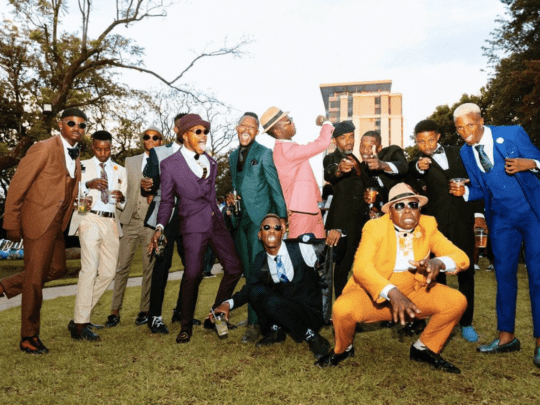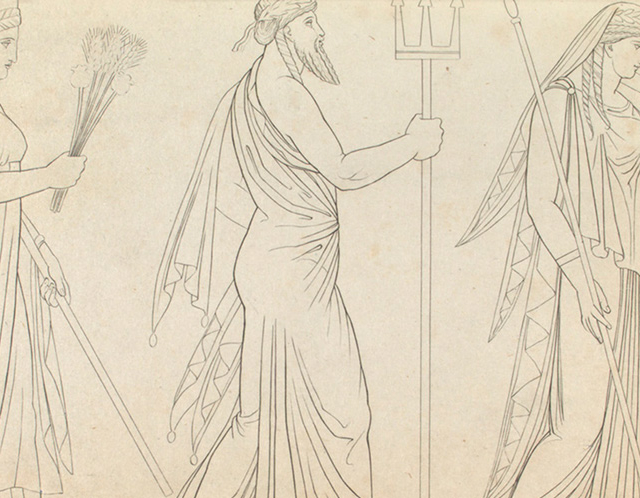It was a summer evening in London in 2012, and it went something like this:
We met at the BFI Lesbian and Gay Film Festival, introduced by a friend. We got on famously, and among other things, discussed Oscar Wilde. We flirted. We did not kiss.
She stretched out her arms into what seemed like an oncoming hug, but instead whispered, “This serendipitous interaction has been distracting and thought-provoking. But you are too fashionable to be gay!”
It’s a dismissal femmes have struggled with for a long time. That I research, study, write on, and enjoy fashion makes it trickier. I am just as comfortable in a tee and boyfriend jeans as I am in a LBD. And because of that, I am often faced with a common query: Are you sure you’re gay?
Femme (derived from the French word for woman) and butch (possible abbreviation of “butcher”; believed to mean “tough kid” and first used in the early 1900s—think George “Butch” Cassidy, a man famous for robbing trains and banks) are terms that describe sexual identity and associative behavior, style, and perception within the lesbian, gay, and bisexual communities. A sect of researchers may label it oversimplification—even a mirroring of heterosexuality—but butches were traditionally expected to exhibit macho traits, while femmes had to play the lady. And with those roles came an unspoken dress code that helped keep things simple in the lesbian community of the 1950s. If you strayed, you were written off as “kiki.”
Is that what I would have been called? Would I have had to pick a side?
American model and television personality Kim Stolz refused to be labeled. “Today I am wearing a dress, and my hair is straight and long. Last week, I went to an event wearing a tie and jeans that were certainly low. I just wish they’d realize no matter how I dress or look, I will always be gay,” the 32-year-old told a journalist back in 2009.
Canadian singer-songwriter k.d. lang birthed the term lesbian chic when she lounged on a barber’s chair for a 1993 cover of Vanity Fair while every heterosexual man’s wet dream, Cindy Crawford, shaved her face. Offending some, inspiring others, she told millions how to dress “dapper butch.” “I’ve always had an interesting relationship with my androgyny,” she told The Guardian in 2008. “It’s kind of breadfruit—it looks poisonous, but it’s really good once you figure how to get into it.”
Androgyny, a word that combines the Greek words for man and woman (andros and gyne), refers to mannerisms and a style of presentation that straddles male and female genders. After riots broke out in 1969 following a police raid on popular New York City gay bar the Stonewall Inn, what’s considered to be the modern LGBT rights movement kicked off across America. Suddenly, the butch-femme prototype was shed for androgyny—work shirt, no makeup, and shorn hair.
For pre-millennial lesbians, it’s likely that the etymology of the term will be traced only as far back as The Ellen DeGeneres Show. The American masses’ favorite lesbian, DeGeneres pairs button-downs, hip-skirting blazers, and approachable sneakers effortlessly. She even has a page titled “My Wardrobe…and I Do Have One” on her website.
But Lang is right. Androgyny is a tough look to crack. At least, the Indian lesbian community certainly seems to think so.
Black on black, tee over jeans, clunky shoes, pruned head. It’s a look some gay women will embrace at work, at play, at Pride, even at the bar. “Stereotypical!” I imagine some of them will scream at me. Perhaps. But often, frighteningly accurate.
New York-based social worker and LGBTQ activist Teresa Theophano offers a defense. “Butches may cross-dress and crop their hair not because they want to be men, but because they are expressing a different way of being a woman, or simply of being gendered. Rather than attempting to replicate traditional masculinity and heterosexuality, butches present a challenge to both in their rejection of how the dominant culture has decided a woman should look and act,” she writes in An Encyclopedia of Gay, Lesbian, Bisexual, Transgender, and Queer Culture.
Mathieu Gugumus Leguillon held the post of head designer at Mumbai concept store Bungalow 8 for eight years. His collections were often heralded for their individualistic streaks and plays of contradiction—fluidity fights structure in his shirtdresses and tuxedo jumpsuits. Men’s shirts beguile lady shoppers with button details and unexpected volume. The time he’s spent in the Indian fashion industry has led him to label Indian lesbian fashion as “confused.” “It’s as if they are unsure of where they belong,” he tells me. “The easier option is to dress like a dude. I’d like to see some of them outgrow their rebellious streak. Dressing attractively is far more revolutionary than not shaving your arms.”
For centuries, clothes have been a significant tool of expression, not just of gender but of the self, too. Fusing the masculine with the feminine helps add mystery, I’ve learned, not to mention it ups your seduction game.
When I came out to my mother two years ago, the first thing she said, after a deathly pause, was, “Will you dress in pants and shirts now?” We are the target of shocking stereotyping because we allow it.
Michelle won’t.
The 38-year-old is a “well-balanced butch-femme” from Portland, Oregon. A picture of her leaning over a car’s engine is accompanied by this admission: “I want people to know whether I’m on top or on the bottom, whether I’m in lipstick or car grease, boxers or a lacy black thong, that I am strong, capable, independent, and 100 percent woman. My identity has never been a crisis to anyone but those around me, who might be bound and determined to pigeonhole me into one category or the other.”
She is one of 100 lesbians Portland-based independent photographer Wendi Kali is documenting for a butch-femme photo project. Funded by Kickstarter, The Butch/Femme Project is an essay-turned-book for which Kali traveled to more than 35 cities to archive butch and femme existence. Every portrait tells a different story of struggle and dreams. Interestingly, the reference to appearance and persona is a constant, as is the craving to evolve, most evident in an admission by Slutty, 36, who says, “After I started hanging out with queens, I realized that I love makeup and hair. I’ve realized recently that although femme in my dress, I’m a bit butch on the inside. It’s an evolving identity. Femme does not equal precious and wilting. We are tough, too.”
Narendra Kumar Ahmed, famous within the Indian fashion fraternity for flying the flag of androgyny in his collections, says blending in may have something to do with the stigma attached to alternate sexuality in India. “For most Indian lesbians,” he says, “fashion isn’t an important statement.”
But it may have to do with the market, too. The queer community, especially in India, is fashion’s biggest blind spot. Butches have trouble finding clothes that fit. Men’s trousers have a waistband too thick; women’s, not as many pockets.
We may have to wait millennia before a Coco Chanel arrives to afford Indian women stylish, collarless, box jackets, or a punk priestess like Vivienne Westwood to infuse postmodern feminism into our wardrobes. A handful of contemporary Indian labels—Rajesh Pratap Singh, Arjun Saluja, Atsu Sekhose, Sailex—have been attempting to blur boundaries, but we need more.
At last count, I found 25 gender terms and their linguistic classifications. It’s a conservative estimate, of course, but it prods me to imagine the possibilities it would present for a wardrobe.






